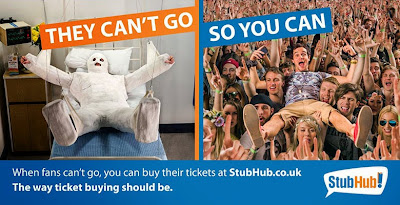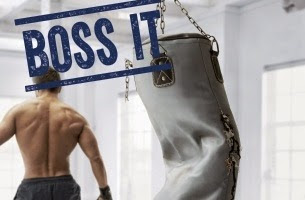On our commute to the city we are bombarded with adverts promoting miracle anti-wrinkle creams or a cure to male pattern baldness. Usually we never give these ads a second glance, probably because we know better than to believe that such a magic elixir exists (well, not an affordable one anyway!). So how do marketers draw the astute commuter's gaze from their smart phone or free newspaper? A spot of humour and elaboration can do the trick!
 |
| Stubhub Advert: "They can't go, so you can" |
By throwing a little elaboration and humour into the mix.
Firstly, the advert is not a visual display of Stub Hub's desire for someone to be hospitalised so that they would be forced to sell their tickets on StubHub's website (well, I hope not anyway!). The point of the advert is to get your attention while making the marketing message clear and concrete.The ad is clearly designed with tongue firmly in cheek and is a bit far fetched, but has successfully made a straightforward, simple message funny and engaging! Putting out an advert featuring the typical reasons for selling your concert tickets like needing extra cash or having a cold, is either to difficult to communicate in print or too boring. So in this case a slight, humorous elaboration on the truth has worked wonders.
 |
| Scimx #Bossit advert The protein shake market is saturated and with a thousand and one different market offerings, it's hard to know which one is the best. In such an environment brands need to look to creative advertising to stand out when their USP or positioning are ineffective. The image above is part of Scimx 's #bossit campaign to promote their new range of health supplements. Demonstrating the functional attributes of its product is nothing new for a sports nutrition company. We have all seen the image of a ripped topless man holding a protein shake in one arm while flexing the other. While all these adverts seem the same, promoting the physical benefits of usage is the best form of advertising for products of this nature. But that does not mean all the adverts have to be predictable or boring. By Scimx displaying a picture of a destroyed punching bag demonstrates the physical benefits of their product but in a novel way. No one is expecting that after drinking one protein shake they will be able to destroy a punching bag, but the image is certainly a head turner. Men are becoming increasingly immune to the use of the "ideals" of male beauty in adverts. This is because everyone seems to be offering the same thing, a big muscular body. When this happens the "ideal" is no longer associated with one specific product thus diminishing its effect on buying behaviour. In order for advertising to utilise the power of these ideals they need to make them realistically unattainable, yet something to strive for. Having a muscular body is something we can all obtain with the right exercise and diet, but punching your way through a punching bag is something reserved for the Gods. The bait of self improvement can be a powerful tool in marketing when it is used correctly, and this is an excellent example of that.We know that are not likely to ever attain such God- like strength. However, by pairing the aspiration with their product in our heads, Scimx are using "fantasy" to crave out a distinctive position for themselves in the marketplace. Well it certainly got me daydreaming! |


















